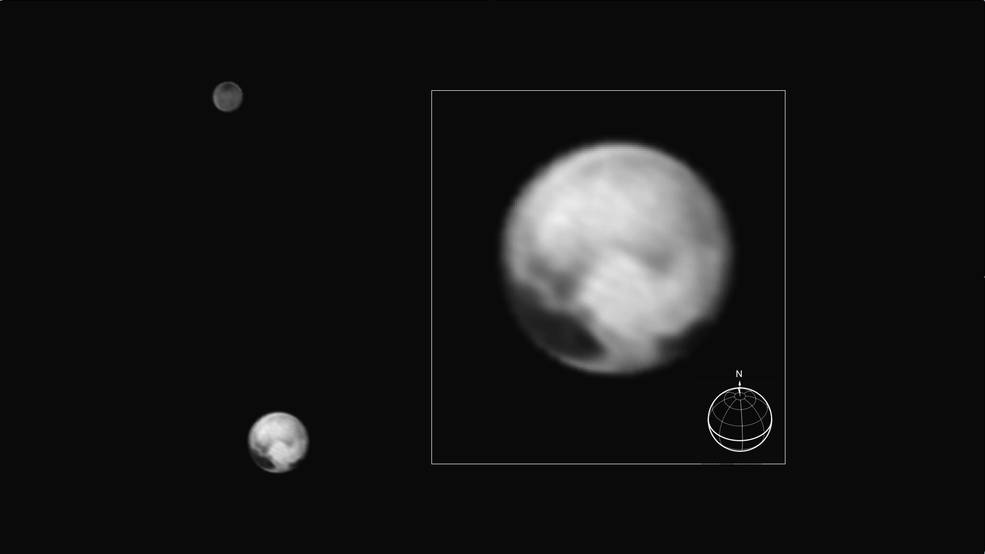A Red Surface Emerges In The Most Recent Images of Pluto
by Sophia Nasr, @Pharaoness
The first color maps produced with data sent from New Horizons have brought to view a reddish brown surface on Pluto, reminiscent of one of Earth’s closest celestial neighbors, Mars.
The origins of the color on Pluto are different than those on Mars. known as "The Red Planet", Mars gets its reddish color from iron oxide, commonly known as rust. Pluto’s reddish brown color on the other hand is believed to be created when cosmic rays and ultraviolet light from the Sun interact with the methane in Pluto’s atmosphere and on its surface. The process forms hydrocarbon molecules which likely give Pluto its color.
"Pluto’s reddish color has been known for decades, but New Horizons is now allowing us to correlate the color of different places on the surface with their geology and soon, with their compositions," said New Horizons principal investigator Alan Stern of the Southwest Research Institute, Boulder, Colorado. "This will make it possible to build sophisticated computer models to understand how Pluto has evolved to its current appearance."
Scientists have been aware that when Lyman-alpha light, or ultraviolet light, strikes methane in Pluto’s atmosphere, it produces substances that are reddish in color, and lead to the creation of tholins, which are complex molecular compounds like those found on Saturn’s moon Titan and Neptune’s moon Triton. The tholins formed in Pluto’s atmosphere eventually fall to its surface, staining the dwarf planet in "gunk" of a reddish hue. Alice, an instrument aboard New Horizons, has recently revealed that Lyman-alpha in diffuse amounts hits Pluto in all directions. The amount Pluto receives is enough to form nearly as much tholin as would direct sunlight. "This means Pluto’s reddening process occurs even on the night side where there’s no sunlight, and in the depths of winter when the sun remains below the horizon for decades at a time," said New Horizons co-investigator Michael Summers, George Mason University, Fairfax, Virginia.

The combined color map of Pluto shows you what you could expect to see if you hitched a ride on the New Horizons spacecraft and took a look at the dwarf planet. In the video above, the leftmost image is a composite of high resolution images taken by the Long Range Reconnaissance Imager (LORRI) aboard the New Horizons spacecraft, revealing Pluto’s northern hemisphere in black-and-white. The rightmost image is a map of Pluto’s colors, created from data taken by the Ralph instrument. The center is a combination of the two, revealing the most detailed map of Pluto we have seen to date.
"Now the unique colors and characteristics of its varied terrains are coming into view," said Simon Porter, a member of the New Horizons Geology and Geophysics team. "Pluto's largest dark spot is clearly more red than the majority of the surface, while the brightest area appears closer to neutral gray.", added Alex Parker, a member of the New Horizons Composition team.
When New Horizons arrives at the Pluto system on July 14th, scientists working on the New Horizons science team hope to learn more about what causes the reddish colors we see on Pluto.
A Complex World Full of Surprises
Images taken by the New Horizons LORRI instrument on July 1st reveal a surface of complexity. Even at a distance of 16 million km (10 million miles) at the time, the images have enough resolution to show details at some 160 km (100 miles) in diameter.
In the image below, we see the side of Pluto that we will get to see in the highest resolution during New Horizons closest approach on July 14. You can see sharper and darker regions surrounded by bright areas, near Pluto’s equator, while moving north, the features become softer, perhaps due to a more diverse, spotted surface.

"Even at this resolution, Pluto looks like no other world in our solar system," said mission scientist Marc Buie of the Southwest Research Institute, Boulder. "We’re already seeing a remarkable amount of detail, and the complexity continues to increase as the images get better."
Now just under 13 million km (8 million miles) from the Pluto system, New Horizons is closing in, set to arrive in just 11 days from today. A world full of surprisingly complex terrain awaits to be unveiled, while citizens of planet Earth await in anticipation for their first true look at this distant world.
For the original press release, click here.
 Sophia Nasr is an astrophysics student at York University. Actively involved in the astronomical community at York U, she is the President of the Astronomy Club at York University and a member of the team at the York University Observatory. She also is involved in university projects, and holds a position in research on dark matter at York U. Holding scientific outreach dear, Sophia is actively involved in social media outlets such as Facebook, Twitter, and Google Plus, where she shares with the world her passion for the universe and how it works.
Sophia Nasr is an astrophysics student at York University. Actively involved in the astronomical community at York U, she is the President of the Astronomy Club at York University and a member of the team at the York University Observatory. She also is involved in university projects, and holds a position in research on dark matter at York U. Holding scientific outreach dear, Sophia is actively involved in social media outlets such as Facebook, Twitter, and Google Plus, where she shares with the world her passion for the universe and how it works.







